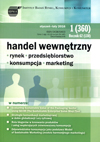Циклические изменения расходов домохозяйств-потребителей и демографических факторов в Латвии в 2004-2014 годах
Cyclical Changes of Households-Consumers Expenditures and Demographic Factors in Latvia in the Years 2004-2014
Author(s): Vilhelma NikitinaSubject(s): Demography and human biology, Economic development, Transformation Period (1990 - 2010), Present Times (2010 - today), EU-Accession / EU-DEvelopment
Published by: Instytut Badań Rynku, Konsumpcji i Koniunktur
Keywords: household income and expenditures; personal consumption; demography in households;
Summary/Abstract: Since 1st May 2004, Latvia is a member of the EU; therefore, the issue concerning changes of financial situation of households during these 10 years has become topical. The main index of welfare within the EU is the average monthly expenses (equivalents) per one person of household. The author in her article uses survey data on household budget, performed by the Central Statistical Bureau of Latvia during the period 2004-2012. On the grounds of summarisation and comparative analysis of these data, there could be established the following main changes: 1) the average expenditures of last 10 years have generally increased, but irregularly – they rapidly increased in 2004-2008, especially within households of selfemployed persons and households of 1-2 persons; they sharply decreased in 2009- 2010, especially in families with small children and households of families living on benefits, the pre-crisis level of expenditures was not revived; 2) the differentiation of households according to the level of consumption, the main reasons of which are the comparatively low income and worsening of demography within households; 3) 10 years of membership in the EU have given no contribution into the content of household expenditures; the priorities of households still are the payments for basic necessities, inter alia, food (constituting 29% of total expenditures), which is indicative of the comparatively low total level of expenditures in Latvia; approximation to the EU level could take at least ten more years. On the basis of the results of statistic data analysis, the author in her article describes the main changes concerning the volume and composition of household consumption (according to the criteria of average monthly expenses of one member) in Latvia after it had joined the European Union (2004-2012). She emphasises the changes of interrelationship between consumption and demographics within households and cyclic economic development of this period.
Journal: Handel Wewnętrzny
- Issue Year: 351/2014
- Issue No: 4
- Page Range: 213-229
- Page Count: 17
- Language: Polish

